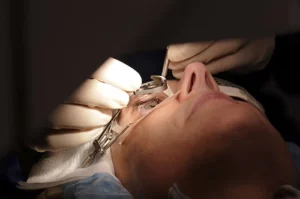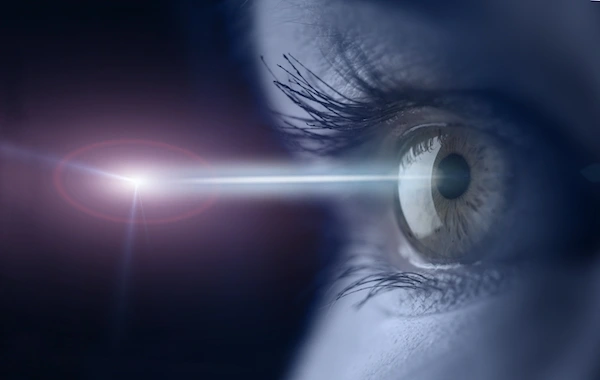Ever heard of DMEK Cornea Surgery and wondered what it entails? You’re not alone! With rapid advancements in eye care, procedures like DMEK are transforming lives, offering quicker recoveries and highly effective results. In this comprehensive guide, we’ll peel back the layers on DMEK, a groundbreaking corneal transplant procedure. From understanding its unique approach to diving deep into its benefits, recovery process, and cost, you’ll get a crystal-clear view of all things DMEK. So, if a clear vision and informed health choices matter to you, read on!
Contents
Understanding DMEK and its Significance
Descemet’s Membrane Endothelial Keratoplasty, commonly known as DMEK, is at the forefront of corneal transplant procedures. But what exactly is DMEK, and why has it become such a talking point in ophthalmology?
DMEK is a precise surgical technique designed to replace only the innermost layer of the cornea when it becomes diseased or damaged. Unlike traditional corneal transplants that replace the full thickness or a more significant portion of the cornea, DMEK specifically targets the endothelial layer, ensuring that the rest of the patient’s cornea remains untouched. This selectiveness is what makes DMEK a game-changer.
The inception of DMEK was driven by the need for a procedure that could offer faster visual recovery, fewer complications, and a reduced risk of graft rejection. And, indeed, DMEK has lived up to these expectations. Its significance in modern ophthalmology can’t be overstated, as it represents a shift towards more targeted, efficient, and patient-friendly interventions in eye care.
DMEK vs. Traditional Corneal Transplants
| Criteria | DMEK | Traditional Transplants |
|---|---|---|
| Extent of Transplant | Targets only the innermost layer of the cornea (endothelial layer). | Full-thickness transplant typically using Penetrating Keratoplasty (PK). |
| Recovery Time | Rapid visual recovery often within days or a few weeks. | Recovery can take several months for the best possible vision due to larger graft and sutures. |
| Risk of Graft Rejection | Lower risk due to the procedure’s targeted nature. | Slightly increased risk due to a larger graft area. |
| Cosmetic Outcomes | Minimal alteration to the eye’s appearance, resulting in a natural post-surgery look. | Possible visible alteration, especially if sutures are apparent. |
In summary, DMEK offers advantages in terms of quicker recovery, reduced risks, and more natural post-surgical appearance, making it an increasingly popular choice over traditional corneal transplant methods.
The Step-by-Step DMEK Procedure

- Preparation:
- Before the procedure begins, the patient is given local anesthesia to numb the eye and ensure comfort throughout the surgery.
- The eye is then cleaned and sterilized.
- Incision:
- A tiny incision, about 2.5 to 3.0 millimeters, is made in the peripheral cornea. This ensures minimal invasion.
- Removal of Damaged Endothelium:
- Using delicate surgical instruments, the damaged endothelial layer (the innermost layer of the cornea) is gently stripped away without disturbing the other layers.
- Preparation of Donor Cornea:
- The donor’s corneal tissue is prepared, and the endothelial layer is carefully separated, ensuring it remains intact.
- Insertion of Donor Cornea:
- The isolated donor endothelium is then rolled, inserted through the small incision, and carefully unfurled inside the eye. This is done with utmost precision to ensure correct positioning.
- Positioning with Air Bubbles:
- Once the donor endothelium is placed correctly, air bubbles are introduced into the eye. These bubbles press the new endothelium against the recipient’s remaining cornea, ensuring adherence.
- The air bubbles serve as a temporary “glue,” holding the new tissue in place until it naturally attaches itself over the next few hours.
- Final Sealing and Recovery:
- The incision is either self-sealing or closed with a suture, depending on the specific circumstances.
- A protective shield is placed over the eye to prevent any accidental rubbing or pressure.
Post-operatively, patients are monitored for a short while and then given specific instructions regarding eye care, medications, and follow-up visits to ensure a smooth healing process.
Benefits of Choosing DMEK
 DMEK has become a preferred choice for many undergoing corneal transplant procedures, and for good reason. Let’s delve into the core benefits of opting for DMEK:
DMEK has become a preferred choice for many undergoing corneal transplant procedures, and for good reason. Let’s delve into the core benefits of opting for DMEK:
- Faster Visual Recovery: Unlike traditional methods that may take months for full vision clarity, many DMEK patients experience improved vision within days to weeks after the procedure.
- Reduced Risk of Graft Rejection: Since only the innermost layer of the cornea is replaced in DMEK, and the rest of the patient’s original cornea remains untouched, there’s a substantially lower chance of the body rejecting the transplant.
- No Sutures Involved: Given the minimally invasive nature of DMEK, the procedure typically doesn’t require any sutures, leading to lesser post-operative complications and discomfort.
- Preservation of Corneal Strength: Since DMEK does not involve replacing the full thickness of the cornea, the structural integrity of the cornea remains largely intact, reducing the risk of future injuries.
- Fewer Post-Operative Complications: With the elimination of stitches and the minimal invasion of the eye, patients experience fewer complications like astigmatism or infections.
- Natural Feel and Appearance: Post DMEK, the eye retains a more natural appearance as the procedure does not introduce notable scars or stitching. Additionally, the absence of stitches ensures that the eye feels more natural and less irritated.
- Higher Success Rate: Clinical studies have shown that DMEK has a higher success rate in terms of graft survival and visual outcomes compared to some traditional methods.
Choosing DMEK can be a game-changer for many, offering a blend of faster recovery with effective, long-lasting results. It’s no wonder that this procedure has gained immense popularity in modern ophthalmology.
Potential Risks and Complications of DMEK
Like all surgical procedures, DMEK, while offering a range of benefits, does come with its set of potential risks and complications. It’s crucial for patients to be well-informed, so they can make a decision with eyes wide open. Here’s a breakdown:
- In some cases, the transplanted tissue might not adhere properly to the patient’s cornea. This could require additional interventions to reattach the graft or introduce a new air bubble to support attachment.
- While the air bubble method is innovative, it can sometimes lead to increased intraocular pressure or even block the pupil temporarily, affecting vision.
- As with any corneal transplant, there’s a risk of endothelial cell loss. This means some cells responsible for keeping the cornea clear might be lost, though this is generally a minimal percentage.
- Any surgery runs the risk of infection. While rare, there’s a possibility of developing an eye infection post-surgery.
- Some patients might experience swelling in the cornea after the surgery, which usually subsides with time and proper medication.
- Although DMEK has a lower rejection rate than traditional full-thickness transplants, the body might still occasionally reject the new tissue.
- In rare cases, patients might experience issues like glare, halos, or double vision post-procedure.
- There’s a minimal risk of bleeding inside the eye, which could require further intervention.
- Scarring, while less common than in traditional procedures, can still occur and might affect vision clarity.
While these risks might sound concerning, it’s essential to understand that they occur in a minority of cases. Proper surgical technique, post-operative care, and timely follow-ups can significantly mitigate these risks. However, being aware helps in making informed decisions and recognizing symptoms early, if they were to manifest.
DMEK Surgery Costs: An Overview
The DMEK (Descemet’s Membrane Endothelial Keratoplasty) procedure, an innovative approach to corneal transplants, has been increasingly preferred for its numerous benefits. However, understanding its cost is crucial for those considering it. Typically, the starting cost of a DMEK surgery is around 60,000. This price can fluctuate depending on factors like the medical center’s reputation, the surgeon’s experience, and the origin of the donor cornea. Additional tests or complementary procedures, if needed, can also influence the final price. While DMEK might seem pricey initially, it’s crucial to factor in its long-term benefits and potential savings from reduced complications when evaluating its cost.
Conclusion
The health of our eyes is paramount, and understanding the available procedures and options is crucial when considering surgery. DMEK has emerged as a cutting-edge solution offering numerous benefits, particularly for those with specific corneal issues. It provides quicker recovery, reduced rejection rates, and promising results, making it a popular choice among patients and surgeons alike. If you’re grappling with cornea-related challenges, don’t delay the journey to clearer vision. Cornea transplant Surgery at EyeMantra is here to guide and assist you every step of the way. Book your free appointment now at 9711116605 and take the first step towards a brighter, clearer tomorrow.
FAQs
1. How long does the DMEK surgery typically take?
The actual DMEK procedure usually lasts about 30 to 60 minutes. However, preparation and post-operative procedures can extend the patient’s stay in the hospital or clinic for a few hours.
2. Is the DMEK procedure painful?
While the surgery itself isn’t painful due to the use of local anesthesia, some patients might experience mild discomfort during the recovery period.
3. Will I need to stay overnight at the hospital after DMEK?
Most DMEK surgeries are performed as outpatient procedures, meaning you won’t usually need an overnight stay. However, it’s essential to arrange transportation as you won’t be able to drive immediately after the surgery.
4. How frequently will I need follow-up appointments post-surgery?
Follow-ups are typically more frequent in the initial weeks following the procedure to ensure the graft is adhering correctly and there are no complications. The frequency will decrease as recovery progresses.
5. Can DMEK be combined with other eye surgeries?
In some cases, DMEK can be combined with other procedures, like cataract surgery. This decision is made on a case-by-case basis, depending on the patient’s unique needs.
6. How soon can I resume regular activities after DMEK?
While many patients can return to their daily routines within a week, it’s essential to avoid strenuous activities or anything that puts undue pressure on the eyes for several weeks. Your surgeon will provide specific guidance based on your case.
7. Are there any specific post-operative care products I need?
Post-surgery, your doctor will typically prescribe antibiotic and anti-inflammatory eye drops. Ensuring cleanliness and following the medication schedule is crucial for successful recovery.



